Report on Managing Financial Principles and Techniques - Finance
VerifiedAdded on 2020/01/15
|35
|8430
|355
Report
AI Summary
This report provides a comprehensive analysis of financial principles and techniques. It begins by exploring various sources of finance available to businesses, including equity, debt, debentures, venture capital, loan syndication, consortium finance, and short-term loans, as well as internal sources like retained earnings. The report then delves into different methods of generating income for a large chain restaurant, such as sales, providing space for events, home delivery services, investment in securities, and opening a bar. It also covers core elements of cost, including material, labor, and direct and indirect costs, and discusses gross profit. The report assesses financial ratios, and presents a management report. Furthermore, the report includes a break-even analysis to determine the optimal alternative for a firm. The report concludes with a summary of the key findings and recommendations.
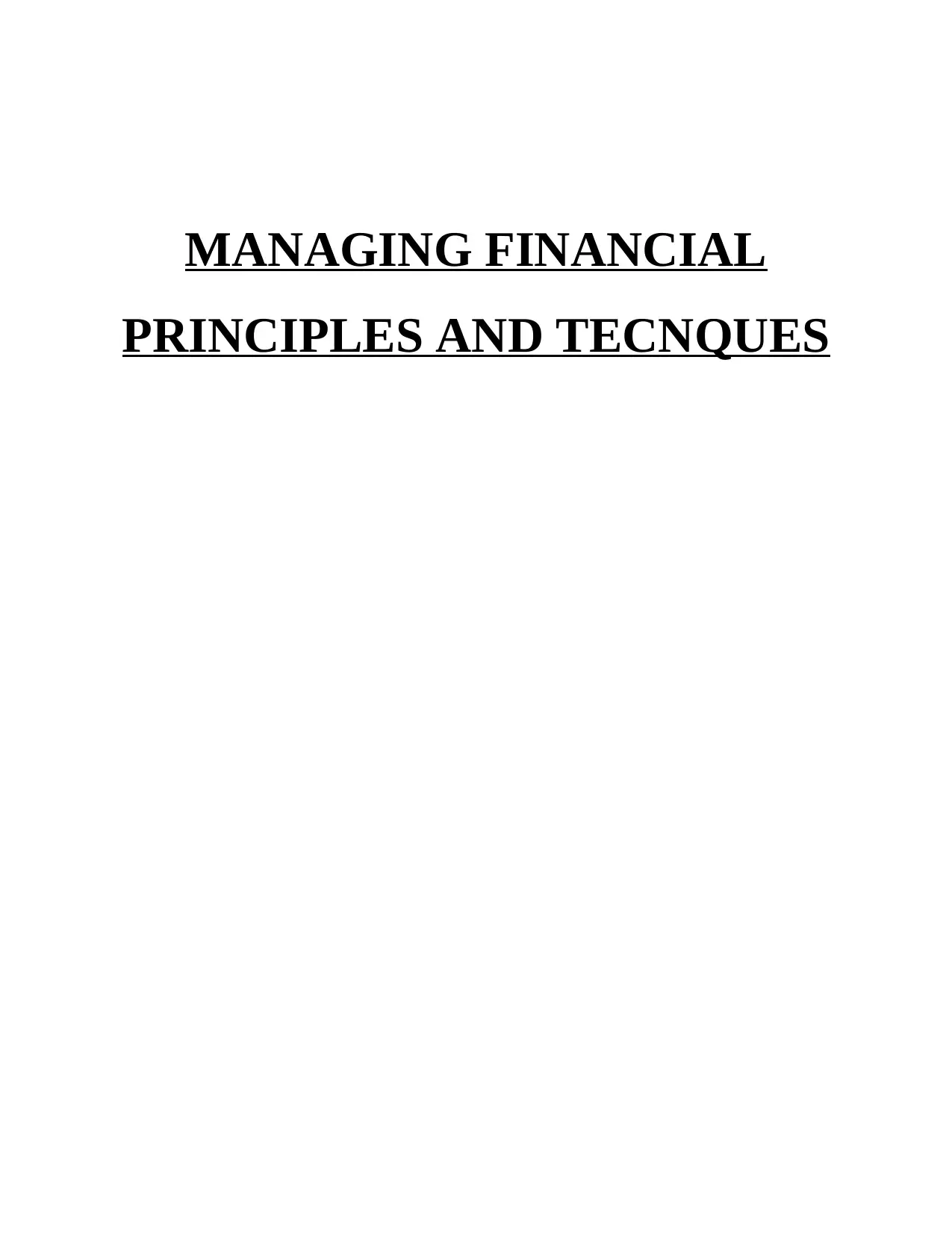
MANAGING FINANCIAL
PRINCIPLES AND TECNQUES
PRINCIPLES AND TECNQUES
Paraphrase This Document
Need a fresh take? Get an instant paraphrase of this document with our AI Paraphraser

TABLE OF CONTENTS
INTRODUCTION...........................................................................................................................3
1.1 Sources of finance available to business..........................................................................1
1.2 Various methods of generating income for large chain restaurant...................................3
TASK 2............................................................................................................................................5
2.1 Elements of cost, gross profit and selling price of the products and services..................5
2.2 Evaluation of controlling cash and stock in the business.................................................6
TASK 3..........................................................................................................................................11
3.3 Process and purpose of budgetary control .....................................................................11
3.4 Analysis of budget variance...........................................................................................13
TASK 4..........................................................................................................................................15
3.1 Assessment of source and structure of trial balance.......................................................15
3.2 Adjustments in financial statements...............................................................................15
4.1 Ratio analysis..................................................................................................................18
4.2 Management report........................................................................................................20
TASK 5..........................................................................................................................................20
5.1 Category of costs............................................................................................................20
5.2 Computation of break even analysis on various alternatives.........................................21
5.3 Selection of alternative...................................................................................................23
CONCLUSION .............................................................................................................................24
REFERENCES..............................................................................................................................25
INTRODUCTION...........................................................................................................................3
1.1 Sources of finance available to business..........................................................................1
1.2 Various methods of generating income for large chain restaurant...................................3
TASK 2............................................................................................................................................5
2.1 Elements of cost, gross profit and selling price of the products and services..................5
2.2 Evaluation of controlling cash and stock in the business.................................................6
TASK 3..........................................................................................................................................11
3.3 Process and purpose of budgetary control .....................................................................11
3.4 Analysis of budget variance...........................................................................................13
TASK 4..........................................................................................................................................15
3.1 Assessment of source and structure of trial balance.......................................................15
3.2 Adjustments in financial statements...............................................................................15
4.1 Ratio analysis..................................................................................................................18
4.2 Management report........................................................................................................20
TASK 5..........................................................................................................................................20
5.1 Category of costs............................................................................................................20
5.2 Computation of break even analysis on various alternatives.........................................21
5.3 Selection of alternative...................................................................................................23
CONCLUSION .............................................................................................................................24
REFERENCES..............................................................................................................................25
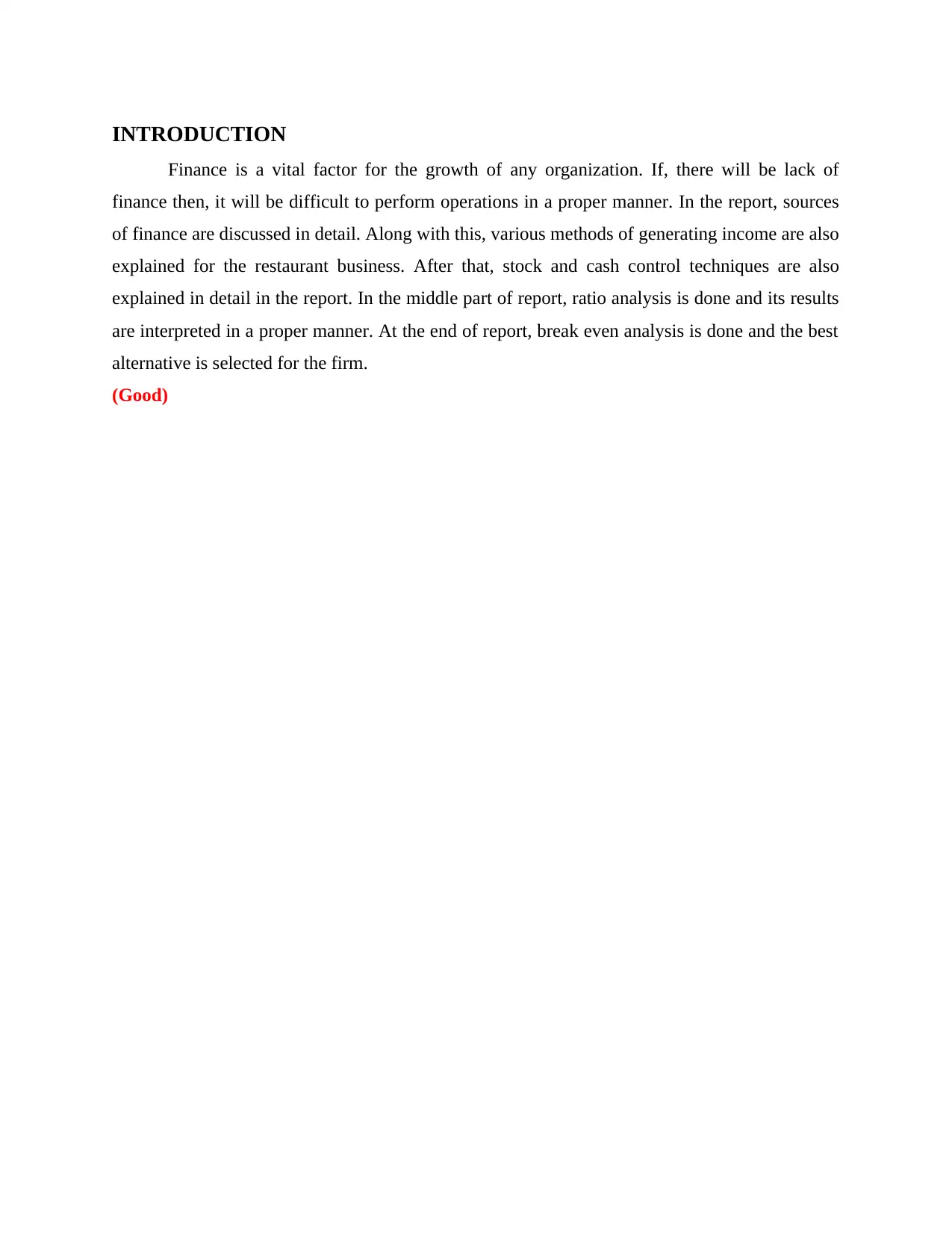
INTRODUCTION
Finance is a vital factor for the growth of any organization. If, there will be lack of
finance then, it will be difficult to perform operations in a proper manner. In the report, sources
of finance are discussed in detail. Along with this, various methods of generating income are also
explained for the restaurant business. After that, stock and cash control techniques are also
explained in detail in the report. In the middle part of report, ratio analysis is done and its results
are interpreted in a proper manner. At the end of report, break even analysis is done and the best
alternative is selected for the firm.
(Good)
Finance is a vital factor for the growth of any organization. If, there will be lack of
finance then, it will be difficult to perform operations in a proper manner. In the report, sources
of finance are discussed in detail. Along with this, various methods of generating income are also
explained for the restaurant business. After that, stock and cash control techniques are also
explained in detail in the report. In the middle part of report, ratio analysis is done and its results
are interpreted in a proper manner. At the end of report, break even analysis is done and the best
alternative is selected for the firm.
(Good)
⊘ This is a preview!⊘
Do you want full access?
Subscribe today to unlock all pages.

Trusted by 1+ million students worldwide
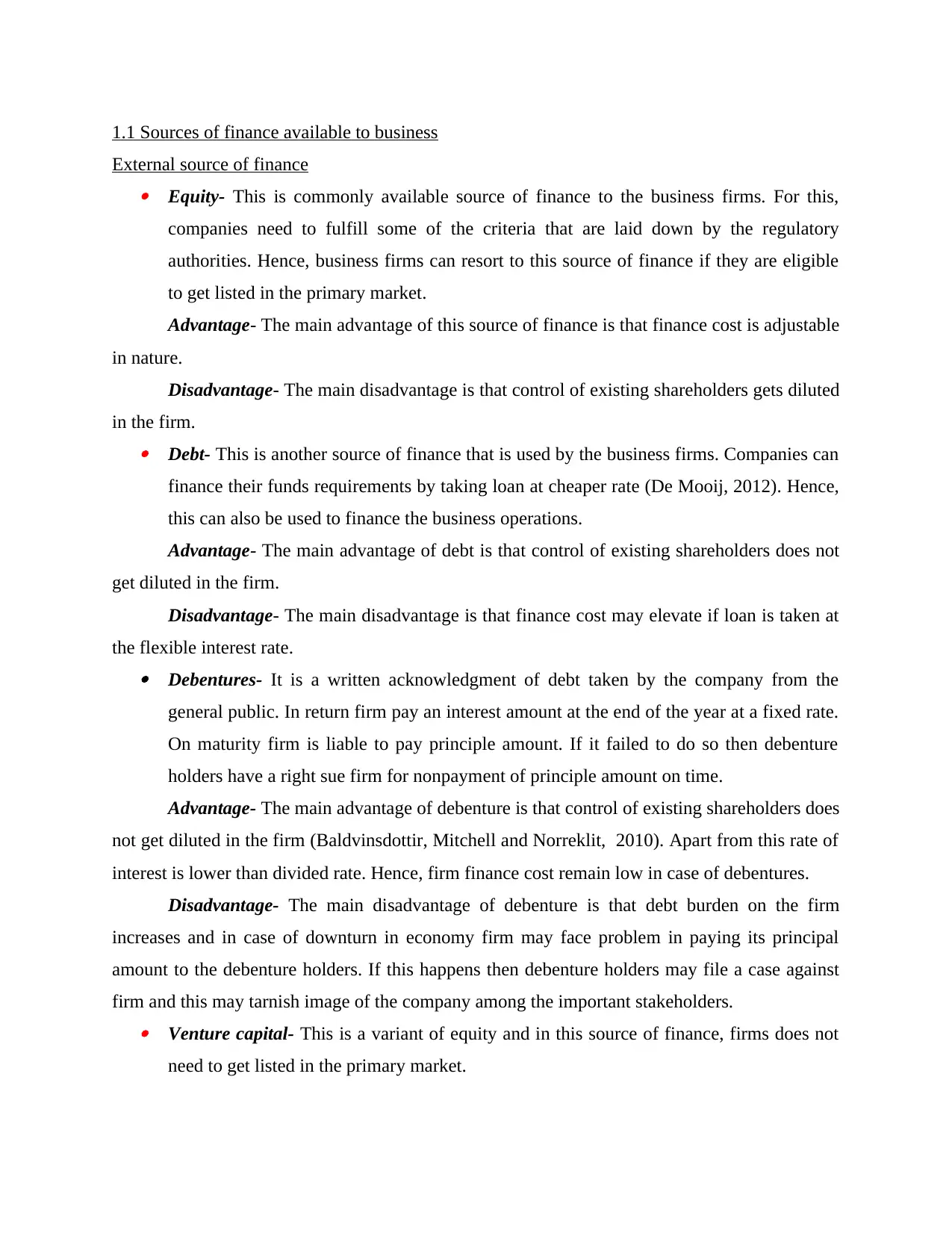
1.1 Sources of finance available to business
External source of finance Equity- This is commonly available source of finance to the business firms. For this,
companies need to fulfill some of the criteria that are laid down by the regulatory
authorities. Hence, business firms can resort to this source of finance if they are eligible
to get listed in the primary market.
Advantage- The main advantage of this source of finance is that finance cost is adjustable
in nature.
Disadvantage- The main disadvantage is that control of existing shareholders gets diluted
in the firm. Debt- This is another source of finance that is used by the business firms. Companies can
finance their funds requirements by taking loan at cheaper rate (De Mooij, 2012). Hence,
this can also be used to finance the business operations.
Advantage- The main advantage of debt is that control of existing shareholders does not
get diluted in the firm.
Disadvantage- The main disadvantage is that finance cost may elevate if loan is taken at
the flexible interest rate. Debentures- It is a written acknowledgment of debt taken by the company from the
general public. In return firm pay an interest amount at the end of the year at a fixed rate.
On maturity firm is liable to pay principle amount. If it failed to do so then debenture
holders have a right sue firm for nonpayment of principle amount on time.
Advantage- The main advantage of debenture is that control of existing shareholders does
not get diluted in the firm (Baldvinsdottir, Mitchell and Norreklit, 2010). Apart from this rate of
interest is lower than divided rate. Hence, firm finance cost remain low in case of debentures.
Disadvantage- The main disadvantage of debenture is that debt burden on the firm
increases and in case of downturn in economy firm may face problem in paying its principal
amount to the debenture holders. If this happens then debenture holders may file a case against
firm and this may tarnish image of the company among the important stakeholders. Venture capital- This is a variant of equity and in this source of finance, firms does not
need to get listed in the primary market.
External source of finance Equity- This is commonly available source of finance to the business firms. For this,
companies need to fulfill some of the criteria that are laid down by the regulatory
authorities. Hence, business firms can resort to this source of finance if they are eligible
to get listed in the primary market.
Advantage- The main advantage of this source of finance is that finance cost is adjustable
in nature.
Disadvantage- The main disadvantage is that control of existing shareholders gets diluted
in the firm. Debt- This is another source of finance that is used by the business firms. Companies can
finance their funds requirements by taking loan at cheaper rate (De Mooij, 2012). Hence,
this can also be used to finance the business operations.
Advantage- The main advantage of debt is that control of existing shareholders does not
get diluted in the firm.
Disadvantage- The main disadvantage is that finance cost may elevate if loan is taken at
the flexible interest rate. Debentures- It is a written acknowledgment of debt taken by the company from the
general public. In return firm pay an interest amount at the end of the year at a fixed rate.
On maturity firm is liable to pay principle amount. If it failed to do so then debenture
holders have a right sue firm for nonpayment of principle amount on time.
Advantage- The main advantage of debenture is that control of existing shareholders does
not get diluted in the firm (Baldvinsdottir, Mitchell and Norreklit, 2010). Apart from this rate of
interest is lower than divided rate. Hence, firm finance cost remain low in case of debentures.
Disadvantage- The main disadvantage of debenture is that debt burden on the firm
increases and in case of downturn in economy firm may face problem in paying its principal
amount to the debenture holders. If this happens then debenture holders may file a case against
firm and this may tarnish image of the company among the important stakeholders. Venture capital- This is a variant of equity and in this source of finance, firms does not
need to get listed in the primary market.
Paraphrase This Document
Need a fresh take? Get an instant paraphrase of this document with our AI Paraphraser
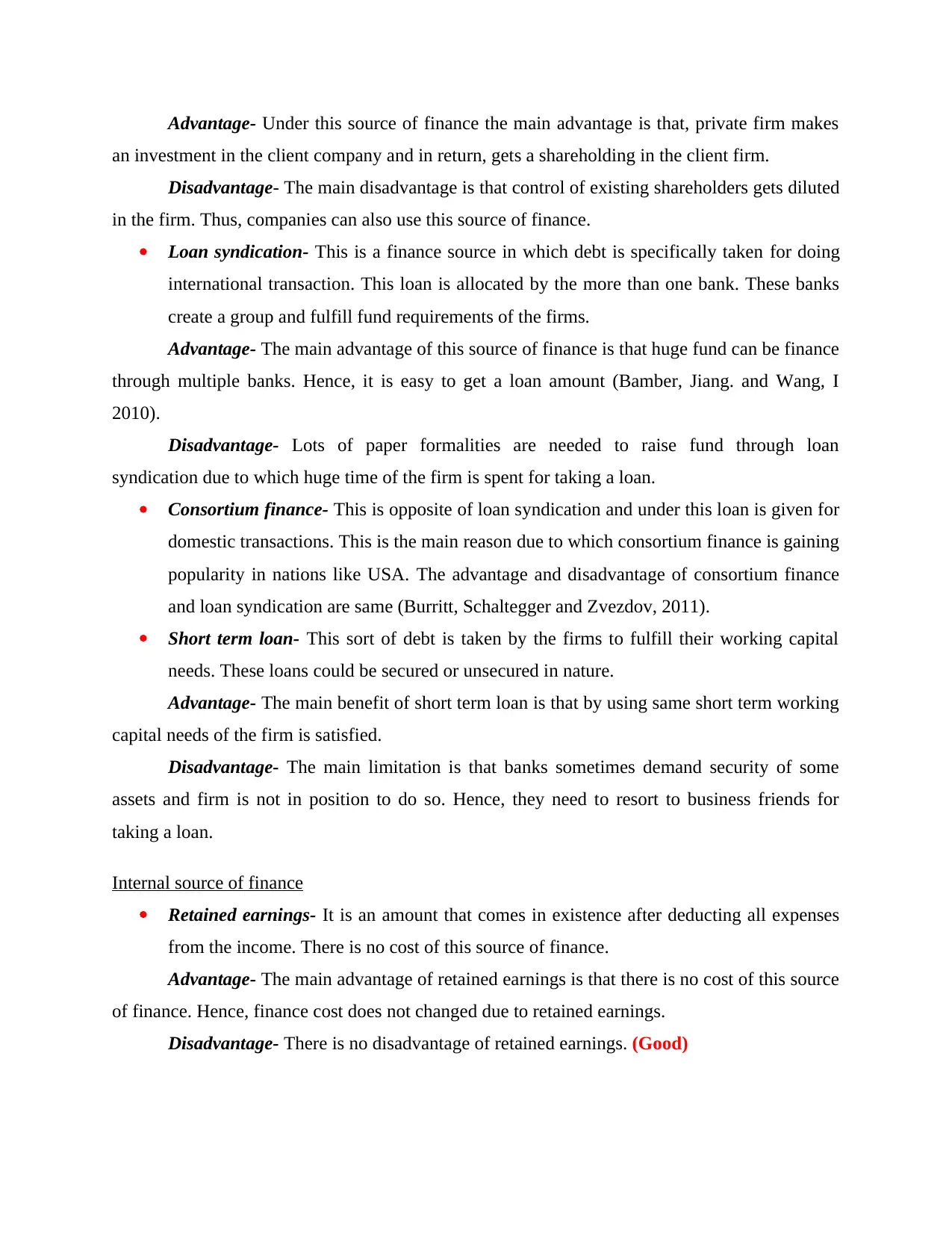
Advantage- Under this source of finance the main advantage is that, private firm makes
an investment in the client company and in return, gets a shareholding in the client firm.
Disadvantage- The main disadvantage is that control of existing shareholders gets diluted
in the firm. Thus, companies can also use this source of finance.
Loan syndication- This is a finance source in which debt is specifically taken for doing
international transaction. This loan is allocated by the more than one bank. These banks
create a group and fulfill fund requirements of the firms.
Advantage- The main advantage of this source of finance is that huge fund can be finance
through multiple banks. Hence, it is easy to get a loan amount (Bamber, Jiang. and Wang, I
2010).
Disadvantage- Lots of paper formalities are needed to raise fund through loan
syndication due to which huge time of the firm is spent for taking a loan.
Consortium finance- This is opposite of loan syndication and under this loan is given for
domestic transactions. This is the main reason due to which consortium finance is gaining
popularity in nations like USA. The advantage and disadvantage of consortium finance
and loan syndication are same (Burritt, Schaltegger and Zvezdov, 2011).
Short term loan- This sort of debt is taken by the firms to fulfill their working capital
needs. These loans could be secured or unsecured in nature.
Advantage- The main benefit of short term loan is that by using same short term working
capital needs of the firm is satisfied.
Disadvantage- The main limitation is that banks sometimes demand security of some
assets and firm is not in position to do so. Hence, they need to resort to business friends for
taking a loan.
Internal source of finance
Retained earnings- It is an amount that comes in existence after deducting all expenses
from the income. There is no cost of this source of finance.
Advantage- The main advantage of retained earnings is that there is no cost of this source
of finance. Hence, finance cost does not changed due to retained earnings.
Disadvantage- There is no disadvantage of retained earnings. (Good)
an investment in the client company and in return, gets a shareholding in the client firm.
Disadvantage- The main disadvantage is that control of existing shareholders gets diluted
in the firm. Thus, companies can also use this source of finance.
Loan syndication- This is a finance source in which debt is specifically taken for doing
international transaction. This loan is allocated by the more than one bank. These banks
create a group and fulfill fund requirements of the firms.
Advantage- The main advantage of this source of finance is that huge fund can be finance
through multiple banks. Hence, it is easy to get a loan amount (Bamber, Jiang. and Wang, I
2010).
Disadvantage- Lots of paper formalities are needed to raise fund through loan
syndication due to which huge time of the firm is spent for taking a loan.
Consortium finance- This is opposite of loan syndication and under this loan is given for
domestic transactions. This is the main reason due to which consortium finance is gaining
popularity in nations like USA. The advantage and disadvantage of consortium finance
and loan syndication are same (Burritt, Schaltegger and Zvezdov, 2011).
Short term loan- This sort of debt is taken by the firms to fulfill their working capital
needs. These loans could be secured or unsecured in nature.
Advantage- The main benefit of short term loan is that by using same short term working
capital needs of the firm is satisfied.
Disadvantage- The main limitation is that banks sometimes demand security of some
assets and firm is not in position to do so. Hence, they need to resort to business friends for
taking a loan.
Internal source of finance
Retained earnings- It is an amount that comes in existence after deducting all expenses
from the income. There is no cost of this source of finance.
Advantage- The main advantage of retained earnings is that there is no cost of this source
of finance. Hence, finance cost does not changed due to retained earnings.
Disadvantage- There is no disadvantage of retained earnings. (Good)
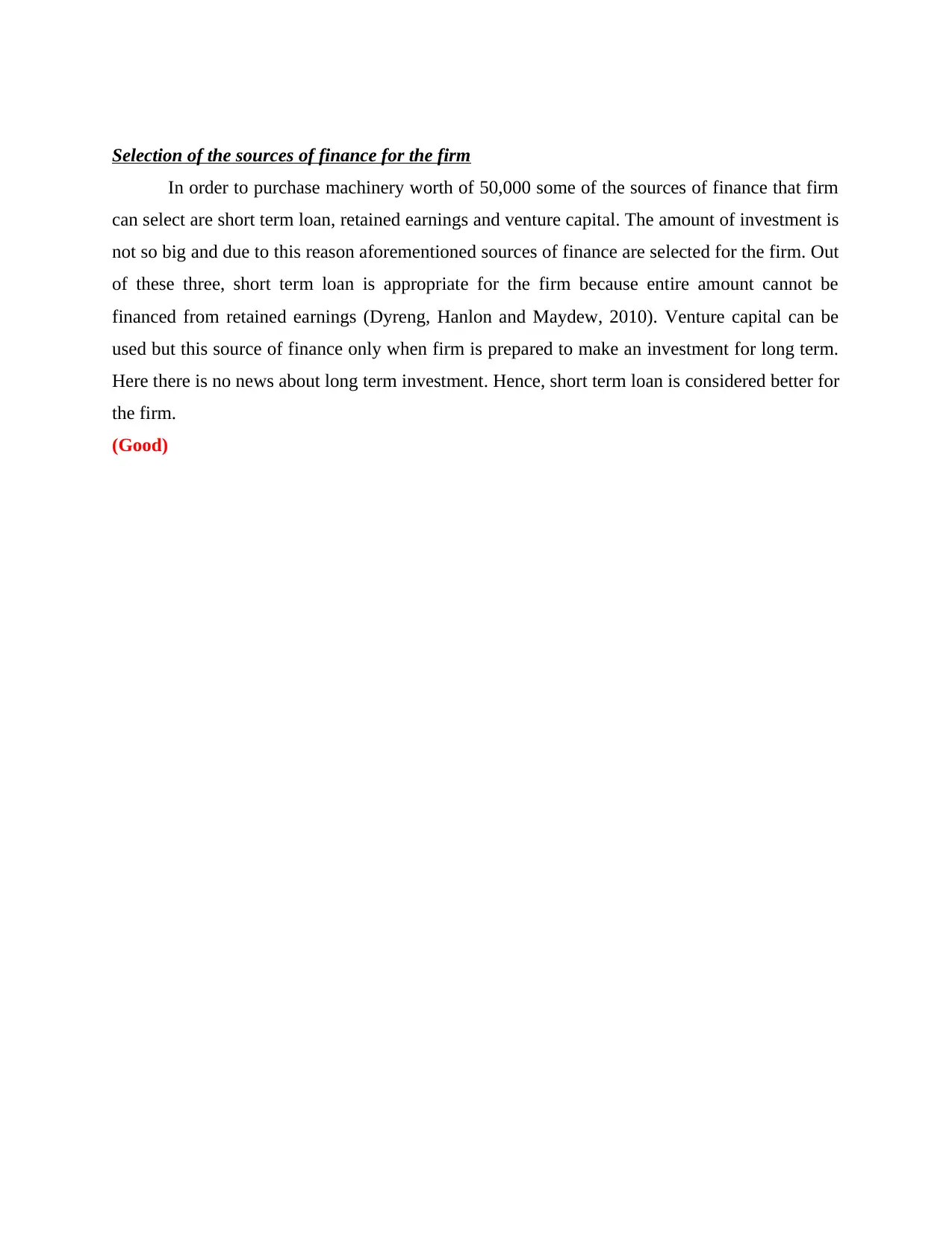
Selection of the sources of finance for the firm
In order to purchase machinery worth of 50,000 some of the sources of finance that firm
can select are short term loan, retained earnings and venture capital. The amount of investment is
not so big and due to this reason aforementioned sources of finance are selected for the firm. Out
of these three, short term loan is appropriate for the firm because entire amount cannot be
financed from retained earnings (Dyreng, Hanlon and Maydew, 2010). Venture capital can be
used but this source of finance only when firm is prepared to make an investment for long term.
Here there is no news about long term investment. Hence, short term loan is considered better for
the firm.
(Good)
In order to purchase machinery worth of 50,000 some of the sources of finance that firm
can select are short term loan, retained earnings and venture capital. The amount of investment is
not so big and due to this reason aforementioned sources of finance are selected for the firm. Out
of these three, short term loan is appropriate for the firm because entire amount cannot be
financed from retained earnings (Dyreng, Hanlon and Maydew, 2010). Venture capital can be
used but this source of finance only when firm is prepared to make an investment for long term.
Here there is no news about long term investment. Hence, short term loan is considered better for
the firm.
(Good)
⊘ This is a preview!⊘
Do you want full access?
Subscribe today to unlock all pages.

Trusted by 1+ million students worldwide
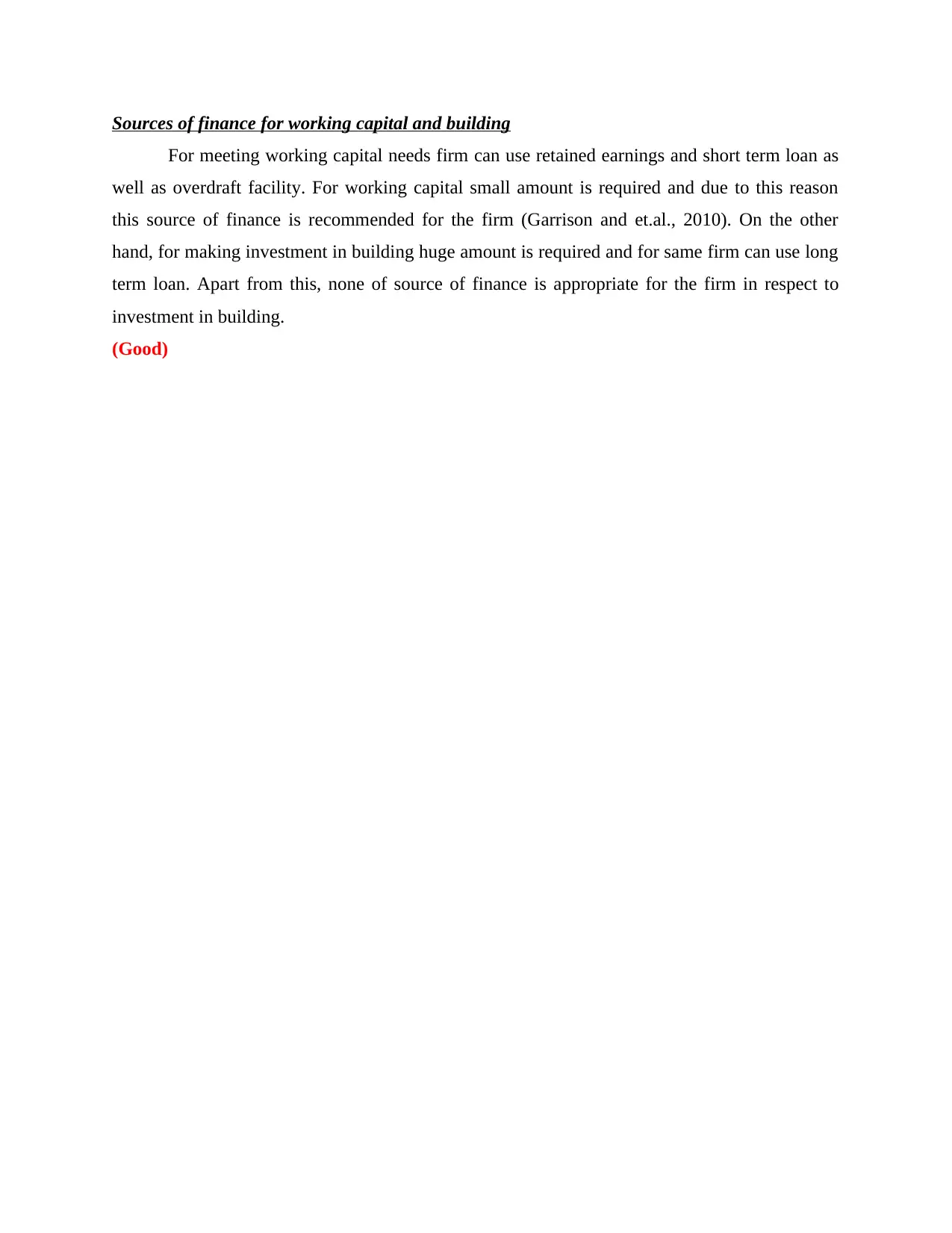
Sources of finance for working capital and building
For meeting working capital needs firm can use retained earnings and short term loan as
well as overdraft facility. For working capital small amount is required and due to this reason
this source of finance is recommended for the firm (Garrison and et.al., 2010). On the other
hand, for making investment in building huge amount is required and for same firm can use long
term loan. Apart from this, none of source of finance is appropriate for the firm in respect to
investment in building.
(Good)
For meeting working capital needs firm can use retained earnings and short term loan as
well as overdraft facility. For working capital small amount is required and due to this reason
this source of finance is recommended for the firm (Garrison and et.al., 2010). On the other
hand, for making investment in building huge amount is required and for same firm can use long
term loan. Apart from this, none of source of finance is appropriate for the firm in respect to
investment in building.
(Good)
Paraphrase This Document
Need a fresh take? Get an instant paraphrase of this document with our AI Paraphraser
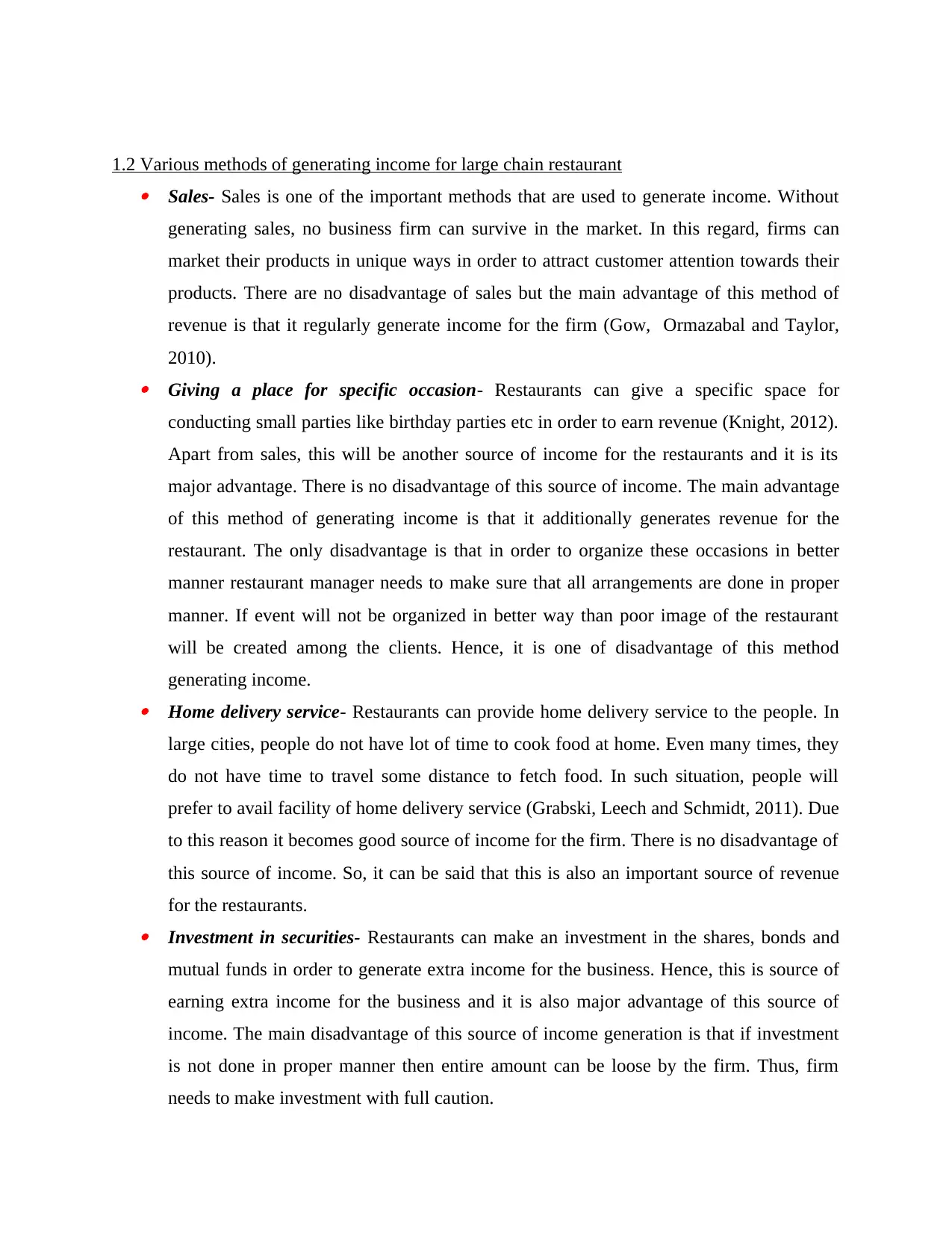
1.2 Various methods of generating income for large chain restaurant Sales- Sales is one of the important methods that are used to generate income. Without
generating sales, no business firm can survive in the market. In this regard, firms can
market their products in unique ways in order to attract customer attention towards their
products. There are no disadvantage of sales but the main advantage of this method of
revenue is that it regularly generate income for the firm (Gow, Ormazabal and Taylor,
2010). Giving a place for specific occasion- Restaurants can give a specific space for
conducting small parties like birthday parties etc in order to earn revenue (Knight, 2012).
Apart from sales, this will be another source of income for the restaurants and it is its
major advantage. There is no disadvantage of this source of income. The main advantage
of this method of generating income is that it additionally generates revenue for the
restaurant. The only disadvantage is that in order to organize these occasions in better
manner restaurant manager needs to make sure that all arrangements are done in proper
manner. If event will not be organized in better way than poor image of the restaurant
will be created among the clients. Hence, it is one of disadvantage of this method
generating income. Home delivery service- Restaurants can provide home delivery service to the people. In
large cities, people do not have lot of time to cook food at home. Even many times, they
do not have time to travel some distance to fetch food. In such situation, people will
prefer to avail facility of home delivery service (Grabski, Leech and Schmidt, 2011). Due
to this reason it becomes good source of income for the firm. There is no disadvantage of
this source of income. So, it can be said that this is also an important source of revenue
for the restaurants. Investment in securities- Restaurants can make an investment in the shares, bonds and
mutual funds in order to generate extra income for the business. Hence, this is source of
earning extra income for the business and it is also major advantage of this source of
income. The main disadvantage of this source of income generation is that if investment
is not done in proper manner then entire amount can be loose by the firm. Thus, firm
needs to make investment with full caution.
generating sales, no business firm can survive in the market. In this regard, firms can
market their products in unique ways in order to attract customer attention towards their
products. There are no disadvantage of sales but the main advantage of this method of
revenue is that it regularly generate income for the firm (Gow, Ormazabal and Taylor,
2010). Giving a place for specific occasion- Restaurants can give a specific space for
conducting small parties like birthday parties etc in order to earn revenue (Knight, 2012).
Apart from sales, this will be another source of income for the restaurants and it is its
major advantage. There is no disadvantage of this source of income. The main advantage
of this method of generating income is that it additionally generates revenue for the
restaurant. The only disadvantage is that in order to organize these occasions in better
manner restaurant manager needs to make sure that all arrangements are done in proper
manner. If event will not be organized in better way than poor image of the restaurant
will be created among the clients. Hence, it is one of disadvantage of this method
generating income. Home delivery service- Restaurants can provide home delivery service to the people. In
large cities, people do not have lot of time to cook food at home. Even many times, they
do not have time to travel some distance to fetch food. In such situation, people will
prefer to avail facility of home delivery service (Grabski, Leech and Schmidt, 2011). Due
to this reason it becomes good source of income for the firm. There is no disadvantage of
this source of income. So, it can be said that this is also an important source of revenue
for the restaurants. Investment in securities- Restaurants can make an investment in the shares, bonds and
mutual funds in order to generate extra income for the business. Hence, this is source of
earning extra income for the business and it is also major advantage of this source of
income. The main disadvantage of this source of income generation is that if investment
is not done in proper manner then entire amount can be loose by the firm. Thus, firm
needs to make investment with full caution.

Opening a bar- Restaurant can open a bar and can provide food and drink facility under
one roof. By doing so they can create their distinct image among the customers. The main
advantage of opening a bar is that every type of person will like to visit restaurant
because it is providing varied services to the customer's (Herman, 2011). The main
disadvantage of opening a bar will be that restaurant will need to make its service
management much stronger. If this will not be done then restaurant will not be able to
reap full advantage of opening a bar in its premises.
Summary of Task 1
Firm investment amount is not so big and due to this reason short term loan, retained
earnings and venture capital are assumed as appropriate source of finance for the firm. Due to
low amount of investment short term loan is suggested to the firm. There are many methods of
generating income and firm must consider advantages and disadvantages of each of them before
selecting an appropriate source of income generation.
(Good)
one roof. By doing so they can create their distinct image among the customers. The main
advantage of opening a bar is that every type of person will like to visit restaurant
because it is providing varied services to the customer's (Herman, 2011). The main
disadvantage of opening a bar will be that restaurant will need to make its service
management much stronger. If this will not be done then restaurant will not be able to
reap full advantage of opening a bar in its premises.
Summary of Task 1
Firm investment amount is not so big and due to this reason short term loan, retained
earnings and venture capital are assumed as appropriate source of finance for the firm. Due to
low amount of investment short term loan is suggested to the firm. There are many methods of
generating income and firm must consider advantages and disadvantages of each of them before
selecting an appropriate source of income generation.
(Good)
⊘ This is a preview!⊘
Do you want full access?
Subscribe today to unlock all pages.

Trusted by 1+ million students worldwide
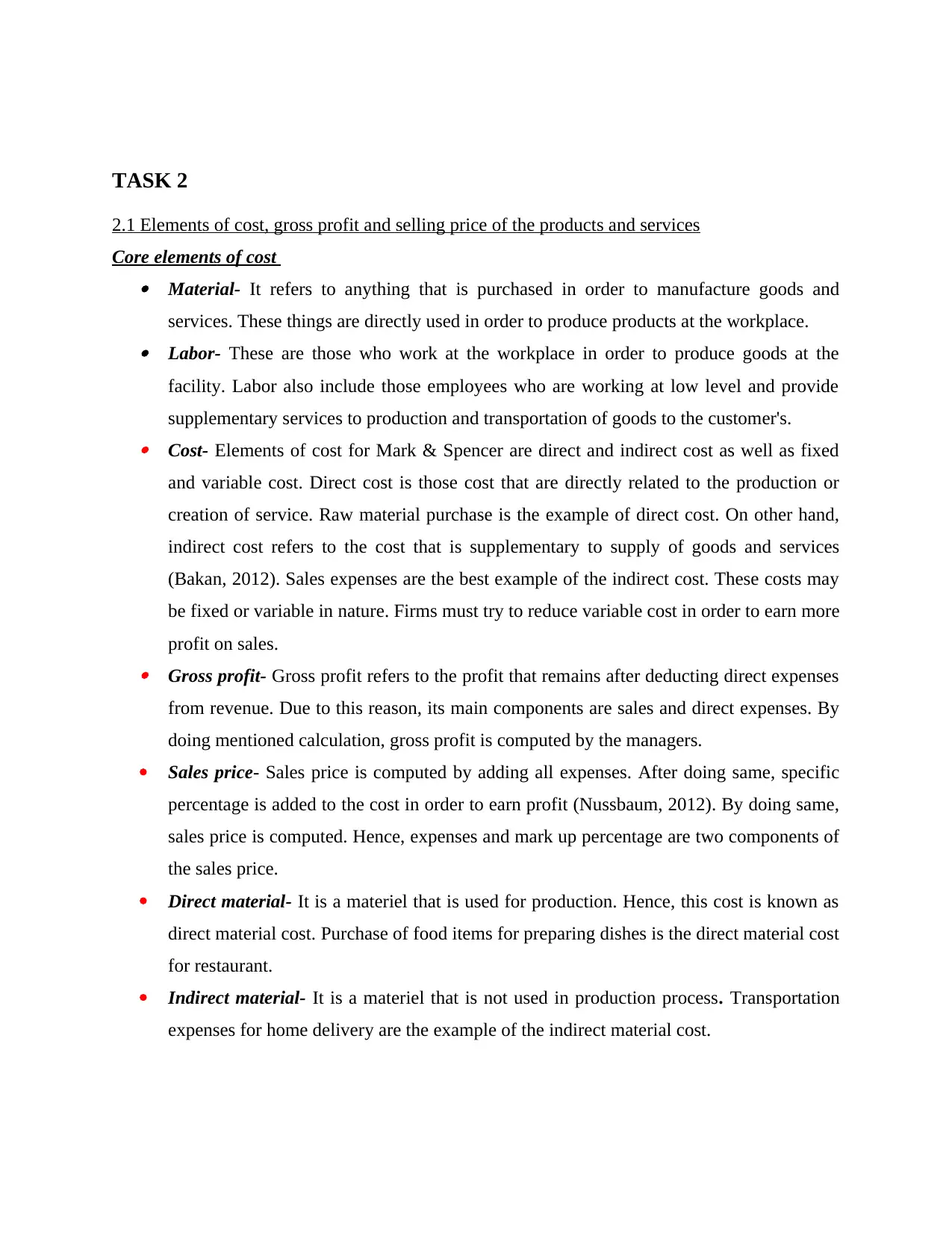
TASK 2
2.1 Elements of cost, gross profit and selling price of the products and services
Core elements of cost Material- It refers to anything that is purchased in order to manufacture goods and
services. These things are directly used in order to produce products at the workplace. Labor- These are those who work at the workplace in order to produce goods at the
facility. Labor also include those employees who are working at low level and provide
supplementary services to production and transportation of goods to the customer's. Cost- Elements of cost for Mark & Spencer are direct and indirect cost as well as fixed
and variable cost. Direct cost is those cost that are directly related to the production or
creation of service. Raw material purchase is the example of direct cost. On other hand,
indirect cost refers to the cost that is supplementary to supply of goods and services
(Bakan, 2012). Sales expenses are the best example of the indirect cost. These costs may
be fixed or variable in nature. Firms must try to reduce variable cost in order to earn more
profit on sales. Gross profit- Gross profit refers to the profit that remains after deducting direct expenses
from revenue. Due to this reason, its main components are sales and direct expenses. By
doing mentioned calculation, gross profit is computed by the managers.
Sales price- Sales price is computed by adding all expenses. After doing same, specific
percentage is added to the cost in order to earn profit (Nussbaum, 2012). By doing same,
sales price is computed. Hence, expenses and mark up percentage are two components of
the sales price.
Direct material- It is a materiel that is used for production. Hence, this cost is known as
direct material cost. Purchase of food items for preparing dishes is the direct material cost
for restaurant.
Indirect material- It is a materiel that is not used in production process. Transportation
expenses for home delivery are the example of the indirect material cost.
2.1 Elements of cost, gross profit and selling price of the products and services
Core elements of cost Material- It refers to anything that is purchased in order to manufacture goods and
services. These things are directly used in order to produce products at the workplace. Labor- These are those who work at the workplace in order to produce goods at the
facility. Labor also include those employees who are working at low level and provide
supplementary services to production and transportation of goods to the customer's. Cost- Elements of cost for Mark & Spencer are direct and indirect cost as well as fixed
and variable cost. Direct cost is those cost that are directly related to the production or
creation of service. Raw material purchase is the example of direct cost. On other hand,
indirect cost refers to the cost that is supplementary to supply of goods and services
(Bakan, 2012). Sales expenses are the best example of the indirect cost. These costs may
be fixed or variable in nature. Firms must try to reduce variable cost in order to earn more
profit on sales. Gross profit- Gross profit refers to the profit that remains after deducting direct expenses
from revenue. Due to this reason, its main components are sales and direct expenses. By
doing mentioned calculation, gross profit is computed by the managers.
Sales price- Sales price is computed by adding all expenses. After doing same, specific
percentage is added to the cost in order to earn profit (Nussbaum, 2012). By doing same,
sales price is computed. Hence, expenses and mark up percentage are two components of
the sales price.
Direct material- It is a materiel that is used for production. Hence, this cost is known as
direct material cost. Purchase of food items for preparing dishes is the direct material cost
for restaurant.
Indirect material- It is a materiel that is not used in production process. Transportation
expenses for home delivery are the example of the indirect material cost.
Paraphrase This Document
Need a fresh take? Get an instant paraphrase of this document with our AI Paraphraser
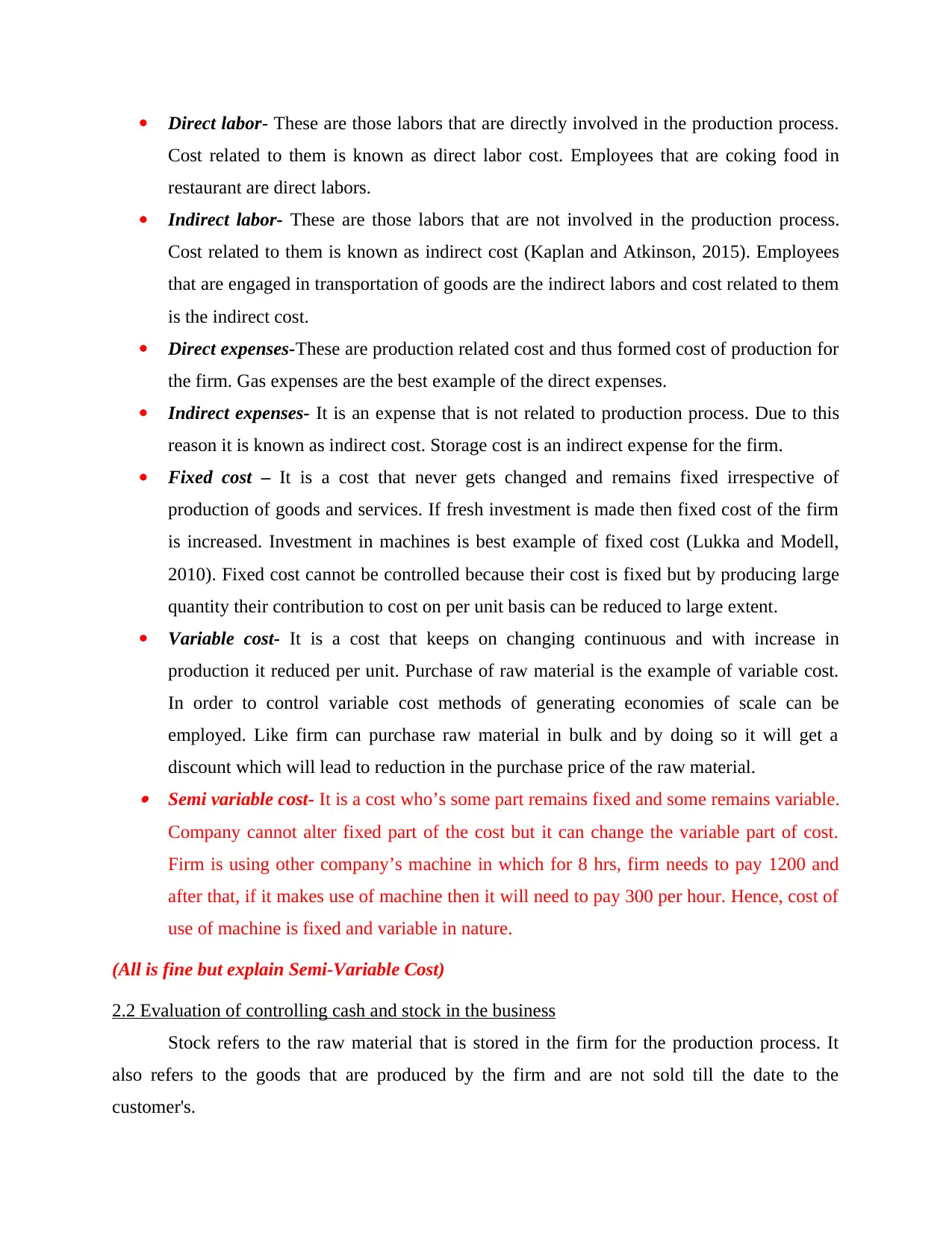
Direct labor- These are those labors that are directly involved in the production process.
Cost related to them is known as direct labor cost. Employees that are coking food in
restaurant are direct labors.
Indirect labor- These are those labors that are not involved in the production process.
Cost related to them is known as indirect cost (Kaplan and Atkinson, 2015). Employees
that are engaged in transportation of goods are the indirect labors and cost related to them
is the indirect cost.
Direct expenses-These are production related cost and thus formed cost of production for
the firm. Gas expenses are the best example of the direct expenses.
Indirect expenses- It is an expense that is not related to production process. Due to this
reason it is known as indirect cost. Storage cost is an indirect expense for the firm.
Fixed cost – It is a cost that never gets changed and remains fixed irrespective of
production of goods and services. If fresh investment is made then fixed cost of the firm
is increased. Investment in machines is best example of fixed cost (Lukka and Modell,
2010). Fixed cost cannot be controlled because their cost is fixed but by producing large
quantity their contribution to cost on per unit basis can be reduced to large extent.
Variable cost- It is a cost that keeps on changing continuous and with increase in
production it reduced per unit. Purchase of raw material is the example of variable cost.
In order to control variable cost methods of generating economies of scale can be
employed. Like firm can purchase raw material in bulk and by doing so it will get a
discount which will lead to reduction in the purchase price of the raw material. Semi variable cost- It is a cost who’s some part remains fixed and some remains variable.
Company cannot alter fixed part of the cost but it can change the variable part of cost.
Firm is using other company’s machine in which for 8 hrs, firm needs to pay 1200 and
after that, if it makes use of machine then it will need to pay 300 per hour. Hence, cost of
use of machine is fixed and variable in nature.
(All is fine but explain Semi-Variable Cost)
2.2 Evaluation of controlling cash and stock in the business
Stock refers to the raw material that is stored in the firm for the production process. It
also refers to the goods that are produced by the firm and are not sold till the date to the
customer's.
Cost related to them is known as direct labor cost. Employees that are coking food in
restaurant are direct labors.
Indirect labor- These are those labors that are not involved in the production process.
Cost related to them is known as indirect cost (Kaplan and Atkinson, 2015). Employees
that are engaged in transportation of goods are the indirect labors and cost related to them
is the indirect cost.
Direct expenses-These are production related cost and thus formed cost of production for
the firm. Gas expenses are the best example of the direct expenses.
Indirect expenses- It is an expense that is not related to production process. Due to this
reason it is known as indirect cost. Storage cost is an indirect expense for the firm.
Fixed cost – It is a cost that never gets changed and remains fixed irrespective of
production of goods and services. If fresh investment is made then fixed cost of the firm
is increased. Investment in machines is best example of fixed cost (Lukka and Modell,
2010). Fixed cost cannot be controlled because their cost is fixed but by producing large
quantity their contribution to cost on per unit basis can be reduced to large extent.
Variable cost- It is a cost that keeps on changing continuous and with increase in
production it reduced per unit. Purchase of raw material is the example of variable cost.
In order to control variable cost methods of generating economies of scale can be
employed. Like firm can purchase raw material in bulk and by doing so it will get a
discount which will lead to reduction in the purchase price of the raw material. Semi variable cost- It is a cost who’s some part remains fixed and some remains variable.
Company cannot alter fixed part of the cost but it can change the variable part of cost.
Firm is using other company’s machine in which for 8 hrs, firm needs to pay 1200 and
after that, if it makes use of machine then it will need to pay 300 per hour. Hence, cost of
use of machine is fixed and variable in nature.
(All is fine but explain Semi-Variable Cost)
2.2 Evaluation of controlling cash and stock in the business
Stock refers to the raw material that is stored in the firm for the production process. It
also refers to the goods that are produced by the firm and are not sold till the date to the
customer's.
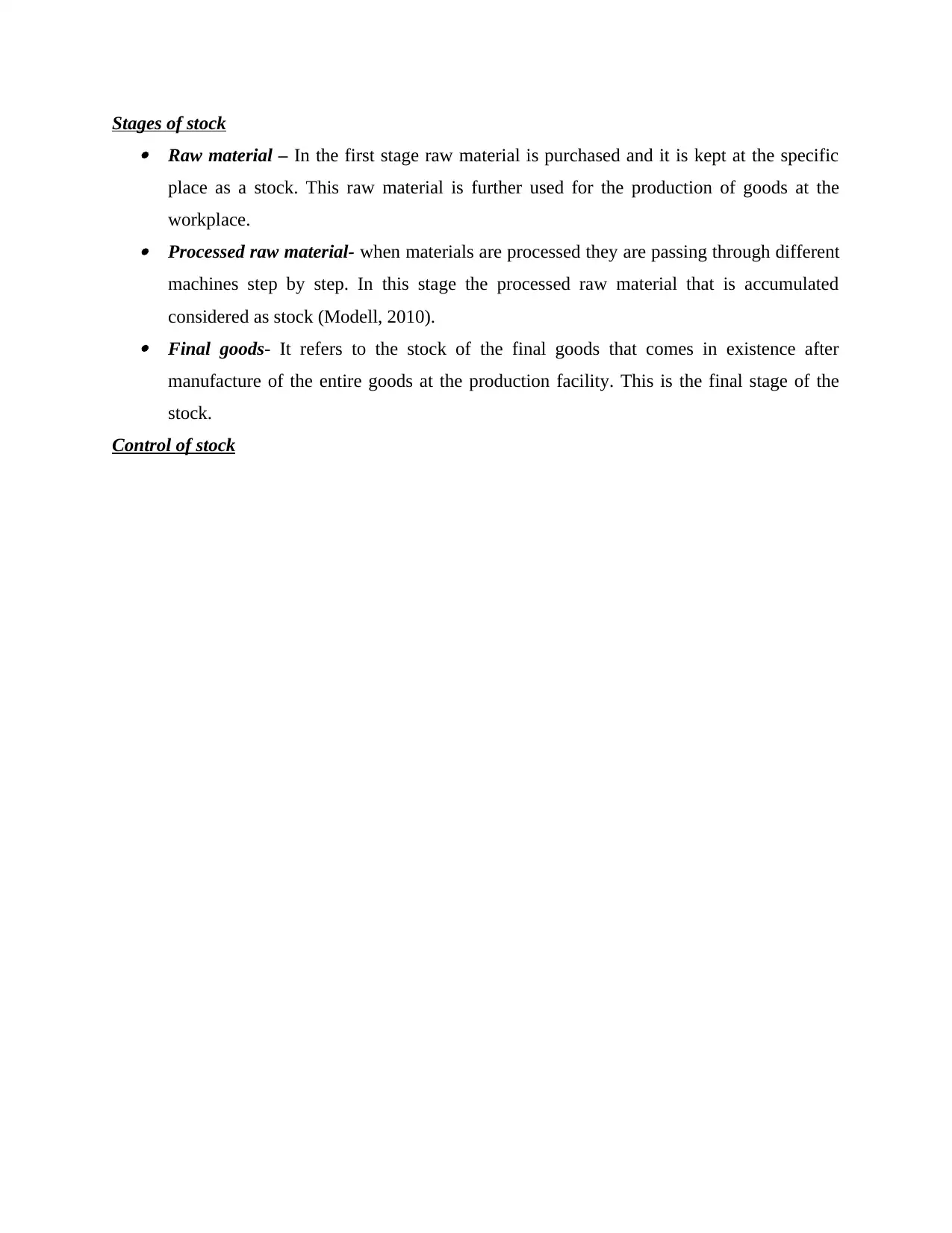
Stages of stock Raw material – In the first stage raw material is purchased and it is kept at the specific
place as a stock. This raw material is further used for the production of goods at the
workplace. Processed raw material- when materials are processed they are passing through different
machines step by step. In this stage the processed raw material that is accumulated
considered as stock (Modell, 2010). Final goods- It refers to the stock of the final goods that comes in existence after
manufacture of the entire goods at the production facility. This is the final stage of the
stock.
Control of stock
place as a stock. This raw material is further used for the production of goods at the
workplace. Processed raw material- when materials are processed they are passing through different
machines step by step. In this stage the processed raw material that is accumulated
considered as stock (Modell, 2010). Final goods- It refers to the stock of the final goods that comes in existence after
manufacture of the entire goods at the production facility. This is the final stage of the
stock.
Control of stock
⊘ This is a preview!⊘
Do you want full access?
Subscribe today to unlock all pages.

Trusted by 1+ million students worldwide
1 out of 35
Related Documents
Your All-in-One AI-Powered Toolkit for Academic Success.
+13062052269
info@desklib.com
Available 24*7 on WhatsApp / Email
![[object Object]](/_next/static/media/star-bottom.7253800d.svg)
Unlock your academic potential
Copyright © 2020–2025 A2Z Services. All Rights Reserved. Developed and managed by ZUCOL.





